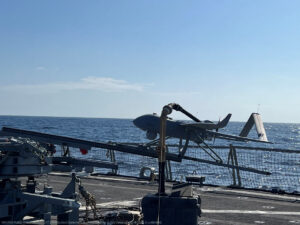
Textron [TXT] said on Monday its Aerosonde small unmanned aircraft system (UAS) conducted its first flight and maritime integration with a Navy’s Arleigh Burke-class (DDG-51) guided missile destroyer last month. Last October, the Navy awarded Textron a multi-year Aerosonde task order to use the aircraft to conduct maritime intelligence, surveillance and reconnaissance (ISR) services aboard two destroyers. In response to questions, the company told Defense Daily the deployed Aerosonde is currently operational with Indo-Pacific Command and is supporting 7th Fleet…

 By
By 








